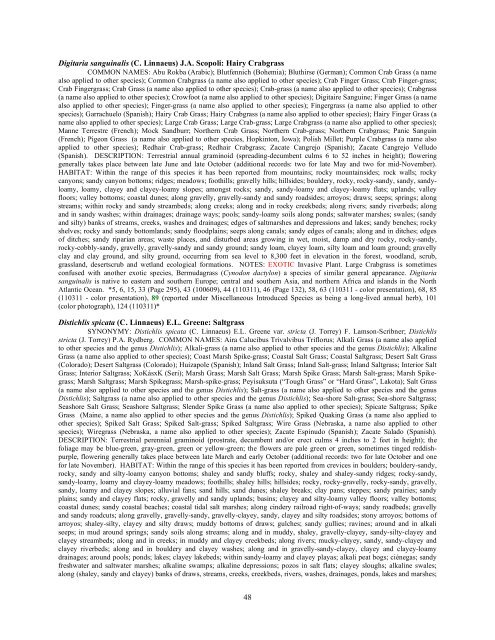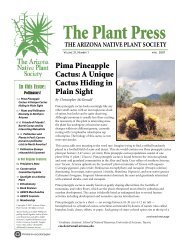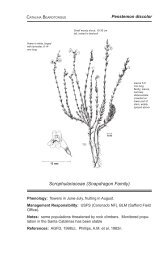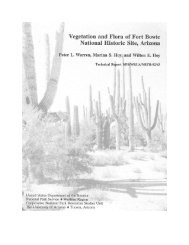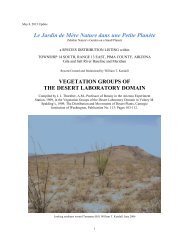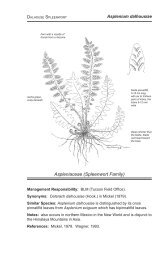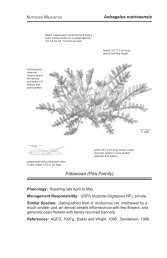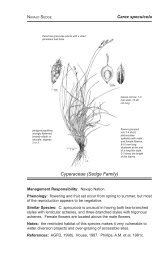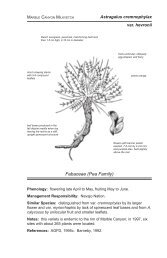T14S.R13E Pima County.AZ 050813 - Arizona Native Plant Society
T14S.R13E Pima County.AZ 050813 - Arizona Native Plant Society
T14S.R13E Pima County.AZ 050813 - Arizona Native Plant Society
You also want an ePaper? Increase the reach of your titles
YUMPU automatically turns print PDFs into web optimized ePapers that Google loves.
Digitaria sanguinalis (C. Linnaeus) J.A. Scopoli: Hairy CrabgrassCOMMON NAMES: Abu Rokba (Arabic); Blutfennich (Bohemia); Bluthirse (German); Common Crab Grass (a namealso applied to other species); Common Crabgrass (a name also applied to other species); Crab Finger Grass; Crab Finger-grass;Crab Fingergrass; Crab Grass (a name also applied to other species); Crab-grass (a name also applied to other species); Crabgrass(a name also applied to other species); Crowfoot (a name also applied to other species); Digitaire Sanguine; Finger Grass (a namealso applied to other species); Finger-grass (a name also applied to other species); Fingergrass (a name also applied to otherspecies); Garrachuelo (Spanish); Hairy Crab Grass; Hairy Crabgrass (a name also applied to other species); Hairy Finger Grass (aname also applied to other species); Large Crab Grass; Large Crab-grass; Large Crabgrass (a name also applied to other species);Manne Terrestre (French); Mock Sandburr; Northern Crab Grass; Northern Crab-grass; Northern Crabgrass; Panic Sanguin(French); Pigeon Grass (a name also applied to other species, Hopkinton, Iowa); Polish Millet; Purple Crabgrass (a name alsoapplied to other species); Redhair Crab-grass; Redhair Crabgrass; Zacate Cangrejo (Spanish); Zacate Cangrejo Velludo(Spanish). DESCRIPTION: Terrestrial annual graminoid (spreading-decumbent culms 6 to 52 inches in height); floweringgenerally takes place between late June and late October (additional records: two for late May and two for mid-November).HABITAT: Within the range of this species it has been reported from mountains; rocky mountainsides; rock walls; rockycanyons; sandy canyon bottoms; ridges; meadows; foothills; gravelly hills; hillsides; bouldery, rocky, rocky-sandy, sandy, sandyloamy,loamy, clayey and clayey-loamy slopes; amongst rocks; sandy, sandy-loamy and clayey-loamy flats; uplands; valleyfloors; valley bottoms; coastal dunes; along gravelly, gravelly-sandy and sandy roadsides; arroyos; draws; seeps; springs; alongstreams; within rocky and sandy streambeds; along creeks; along and in rocky creekbeds; along rivers; sandy riverbeds; alongand in sandy washes; within drainages; drainage ways; pools; sandy-loamy soils along ponds; saltwater marshes; swales; (sandyand silty) banks of streams, creeks, washes and drainages; edges of saltmarshes and depressions and lakes; sandy benches; rockyshelves; rocky and sandy bottomlands; sandy floodplains; seeps along canals; sandy edges of canals; along and in ditches; edgesof ditches; sandy riparian areas; waste places, and disturbed areas growing in wet, moist, damp and dry rocky, rocky-sandy,rocky-cobbly-sandy, gravelly, gravelly-sandy and sandy ground; sandy loam, clayey loam, silty loam and loam ground; gravellyclay and clay ground, and silty ground, occurring from sea level to 8,300 feet in elevation in the forest, woodland, scrub,grassland, desertscrub and wetland ecological formations. NOTES: EXOTIC Invasive <strong>Plant</strong>. Large Crabgrass is sometimesconfused with another exotic species, Bermudagrass (Cynodon dactylon) a species of similar general appearance. Digitariasanguinalis is native to eastern and southern Europe; central and southern Asia, and northern Africa and islands in the NorthAtlantic Ocean. *5, 6, 15, 33 (Page 295), 43 (100609), 44 (110311), 46 (Page 132), 58, 63 (110311 - color presentation), 68, 85(110311 - color presentation), 89 (reported under Miscellaneous Introduced Species as being a long-lived annual herb), 101(color photograph), 124 (110311)*Distichlis spicata (C. Linnaeus) E.L. Greene: SaltgrassSYNONYMY: Distichlis spicata (C. Linnaeus) E.L. Greene var. stricta (J. Torrey) F. Lamson-Scribner; Distichlisstricta (J. Torrey) P.A. Rydberg. COMMON NAMES: Aira Calucibus Trivalvibus Triflorus; Alkali Grass (a name also appliedto other species and the genus Distichlis); Alkali-grass (a name also applied to other species and the genus Distichlis); AlkalineGrass (a name also applied to other species); Coast Marsh Spike-grass; Coastal Salt Grass; Coastal Saltgrass; Desert Salt Grass(Colorado); Desert Saltgrass (Colorado); Huizapole (Spanish); Inland Salt Grass; Inland Salt-grass; Inland Saltgrass; Interior SaltGrass; Interior Saltgrass; XoKásxK (Seri); Marsh Grass; Marsh Salt Grass; Marsh Spike Grass; Marsh Salt-grass; Marsh Spikegrass;Marsh Saltgrass; Marsh Spikegrass; Marsh-spike-grass; Peyisuksuta (“Tough Grass” or “Hard Grass”, Lakota); Salt Grass(a name also applied to other species and the genus Distichlis); Salt-grass (a name also applied to other species and the genusDistichlis); Saltgrass (a name also applied to other species and the genus Distichlis); Sea-shore Salt-grass; Sea-shore Saltgrass;Seashore Salt Grass; Seashore Saltgrass; Slender Spike Grass (a name also applied to other species); Spicate Saltgrass; SpikeGrass (Maine, a name also applied to other species and the genus Distichlis); Spiked Quaking Grass (a name also applied toother species); Spiked Salt Grass; Spiked Salt-grass; Spiked Saltgrass; Wire Grass (Nebraska, a name also applied to otherspecies); Wiregrass (Nebraska, a name also applied to other species); Zacate Espinudo (Spanish); Zacate Salado (Spanish).DESCRIPTION: Terrestrial perennial graminoid (prostrate, decumbent and/or erect culms 4 inches to 2 feet in height); thefoliage may be blue-green, gray-green, green or yellow-green; the flowers are pale green or green, sometimes tinged reddishpurple,flowering generally takes place between late March and early October (additional records: two for late October and onefor late November). HABITAT: Within the range of this species it has been reported from crevices in boulders; bouldery-sandy,rocky, sandy and silty-loamy canyon bottoms; shaley and sandy bluffs; rocky, shaley and shaley-sandy ridges; rocky-sandy,sandy-loamy, loamy and clayey-loamy meadows; foothills; shaley hills; hillsides; rocky, rocky-gravelly, rocky-sandy, gravelly,sandy, loamy and clayey slopes; alluvial fans; sand hills; sand dunes; shaley breaks; clay pans; steppes; sandy prairies; sandyplains; sandy and clayey flats; rocky, gravelly and sandy uplands; basins; clayey and silty-loamy valley floors; valley bottoms;coastal dunes; sandy coastal beaches; coastal tidal salt marshes; along cindery railroad right-of-ways; sandy roadbeds; gravellyand sandy roadcuts; along gravelly, gravelly-sandy, gravelly-clayey, sandy, clayey and silty roadsides; stony arroyos; bottoms ofarroyos; shaley-silty, clayey and silty draws; muddy bottoms of draws; gulches; sandy gullies; ravines; around and in alkaliseeps; in mud around springs; sandy soils along streams; along and in muddy, shaley, gravelly-clayey, sandy-silty-clayey andclayey streambeds; along and in creeks; in muddy and clayey creekbeds; along rivers; mucky-clayey, sandy, sandy-clayey andclayey riverbeds; along and in bouldery and clayey washes; along and in gravelly-sandy-clayey, clayey and clayey-loamydrainages; around pools; ponds; lakes; clayey lakebeds; within sandy-loamy and clayey playas; alkali peat bogs; ciénegas; sandyfreshwater and saltwater marshes; alkaline swamps; alkaline depressions; pozos in salt flats; clayey sloughs; alkaline swales;along (shaley, sandy and clayey) banks of draws, streams, creeks, creekbeds, rivers, washes, drainages, ponds, lakes and marshes;48


